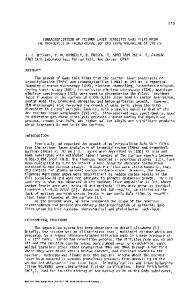The Decomposition of Trimethylgallium and Trimethylaluminum on Si(100)
- PDF / 457,919 Bytes
- 6 Pages / 420.48 x 639 pts Page_size
- 58 Downloads / 291 Views
The Decomposition of Trimethylgalllum and Trimethylaluminum on SI(100) F. Lee, T. R. Gow, R. Lin, A. L. Backman, D. Lubben, and R. I. Masel, University of Illinois, 1209 W California St., Urbana I1.,61801.
ABSTRACT
The decomposition of trimethylgallium (TMG) and trimethylaluminum (TMA) on Si(100) is studied by TPD, XPS, and EELS. It is found that the decomposition of TMG is largely an intramolecular process. First one of the methyl groups in the TMG reacts with a hydrogen in another methyl group liberating methane. This leaves a CH2 group bound to the gallium which is seen clearly in EELS. Subsequently, another hydrogen reacts with a methyl group producing additional methane. This leaves a gallium atom and a CH group on the surface. Hydrogen desorbs, while carbon is incorporated into the growing film. Careful calibration of the peak areas in the TPD data indicates that 2.1 ± 0.3 moles of methane, 0.5 ± 0.03 moles of hydrogen, 1 mole of gallium, and 0.95 ± 0.1 moles of surface carbon are produced for every mole of TMG which decomposes. Since, the decomposition ratio is independent of the state of the surface, the surface orientation, and the level of impurities on the surface, it appears that the surface is not a direct participant in the reaction. TMA adsorbs as dimers. However, the dimers decompose upon heating to 400 K. Thereafter, the chemistry of TMA decomposition is similar to that for TMG. Nonetheless, the product ratio varies with the TMA coverage, the state of the surface, and the aluminum coverage. Also, silicon-carbon bonds are evident at 600 K in EELS. It is suggested, therefore, that the decomposition of TMA is similar to that of TMG, except that methyl groups in TMA have a tendency to migrate to the support. In both TMA and TMG, carbon incorporation is an intrinsic part of the decomposition process. This suggests that TMA and TMG would not be appropriate source gases when one needs to produce films with very low carbon levels. INTRODUCTION
Trlmethylgallium(TMG) and trlmethylaluminum(TMA) are important source gases for MOCVD and MOMBE. Films grow easily. However, carbon incorporation during the film growth process has been a persistent problem. The objective of this paper is to examine the decomposition of TMA and TMG on a Si(100) substrate using standard surface spectroscopic techniques to try to get some insight on the carbon incorporation process. EXPERIMENTAL
The experiments presented here were done using standard surface spectroscopic techniques. A 8 il-cm Si(100) sample was cut from a standard wafer. The sample was rinsed in HF, then mounted in a standard UHV system. The sample was then repeatedly sputtered and annealed until no impurities could be detected by AES. Next, the sample was then dosed with either TMA or TMG through a calibrated leak system. The sample was then examined with temperature programmed desorption (TPD), x-ray photoemission spectroscopy (XPS) or electron energy loss spectroscopy (EELS). All of the procedures were standard. One is referred to more complete descriptions of
Data Loading...










